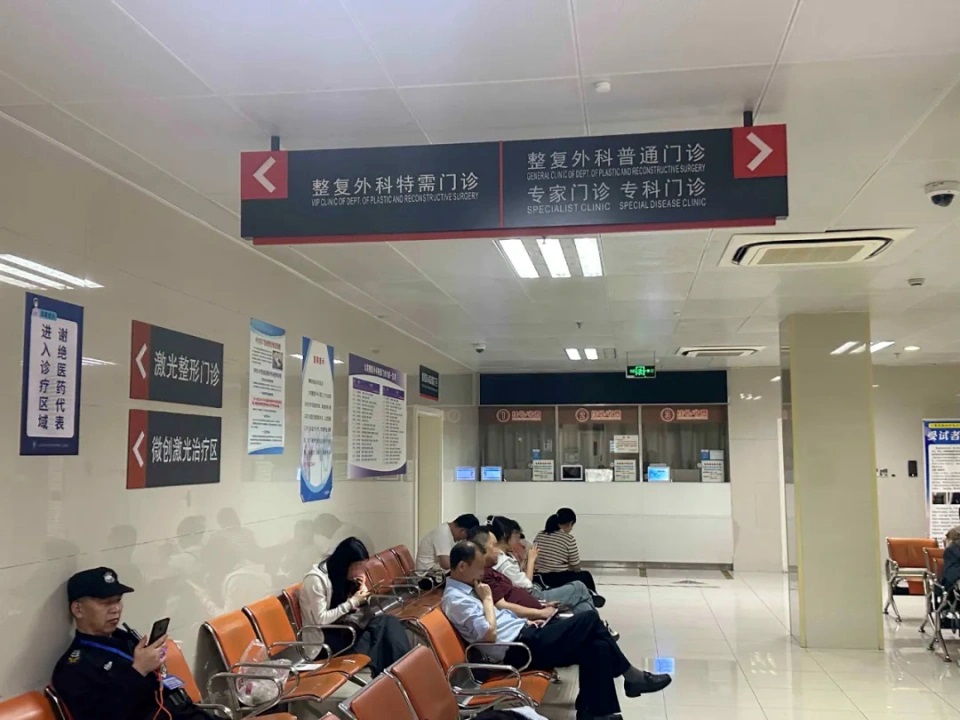Survey on female private part plastic surgery: the chaos behind the 40 billion yuan

On May 2, 23-year-old Cheng Sha received labiaplasty at a private medical beauty institution located in the core area of Shenzhen’s CBD. She recalled that it was a holiday and there was a constant flow of people in the lobby of the institution. There were seven or eight women waiting in line before the operation.
Cheng Sha told China News Weekly that her labia minora had been congenitally enlarged since junior high school. She often felt uncomfortable due to friction when walking, accompanied by a sense of shame, which once made her feel inferior. After adulthood, this discomfort became more and more obvious, especially during menstruation, when the protruding part was prone to pain and was not beautiful in appearance. After weighing the pros and cons, she decided to undergo surgery.
This was Cheng Sha’s first contact with plastic surgery. In the public’s impression, medical beauty focuses more on facial changes, but according to a medical beauty industry practitioner who revealed to China News Weekly, many women currently use private part plastic surgery as the starting point of medical beauty.
“Private plastic surgery” was first proposed by private medical beauty institutions. It is called “perineal plastic surgery” in formal medicine and covers both men and women. Today, this concept is more directed at women. This field, which was once marginalized by the traditional medical system, is becoming a new track for the medical beauty industry.
According to data released by Hejun Consulting, the scale of China’s private medical beauty market has reached 42 billion yuan in 2023, and is expected to grow to about 100.7 billion yuan in 2027. However, in this rapidly growing market, the boundary between real medical needs and commercial marketing is not clear. At the same time, technological progress is also accompanied by multiple challenges such as ethics and medical standards.
Labiaplasty ranks first
“Doctor, you need to be more careful when doing the operation. I spent 1 million yuan on private plastic surgery before. I can’t let the money I spent before go down the drain.” Duan Tao, director of the Department of Obstetrics and Gynecology and the Department of Reproductive Medicine of Women and Children at Shanghai Oriental Hospital affiliated to Tongji University, told China News Weekly that this was what a woman said to an obstetrician and gynecologist when she gave birth in a private hospital in Shanghai in May this year. On May 14, a consultant from a high-end private medical beauty institution in Shanghai revealed to China News Weekly that on that day alone, his colleague signed a private plastic surgery order worth one million yuan.
Private plastic surgery covers both surgical and non-surgical projects to meet women’s needs for firming, rejuvenation, and sensitivity. At present, domestic private plastic surgery is mainly concentrated in large tertiary hospitals such as the Plastic Surgery Hospital of the Chinese Academy of Medical Sciences (i.e. “Beijing Badachu Plastic Surgery”), the Ninth People’s Hospital Affiliated to Shanghai Jiaotong University School of Medicine (hereinafter referred to as “Shanghai Ninth Hospital”), and some medical beauty institutions with medical qualifications. Most non-surgical projects are carried out in private hospitals.
Liu Yang, chief physician of the Plastic Surgery Department of Shanghai Ninth Hospital, has been engaged in clinical private plastic surgery for more than 20 years, completing an average of 10 to 15 operations per week. According to her observation, about 80% of the women who visit are between 20 and 45 years old, and their needs are mainly divided into two categories: one is appearance repair, involving labia minora and majora plastic surgery, and clitoral circumcision plastic surgery; the other is function improvement, involving vaginal tightening, pelvic floor function repair and other operations.
Many doctors from top three hospitals interviewed in China told China Newsweek that in terms of the number of private plastic surgery operations, labiaplasty ranks first, followed by vaginal tightening and hymen repair. Li Fengyong, chief physician of the Beijing Badachu Plastic Surgery Department, has a total of 9 surgeons in his department. Among the thousands of private plastic surgery operations completed each year, labiaplasty accounts for more than half.
The demands of patients with different surgeries vary. Li Fengyong said that in the early years, patients who underwent labiaplasty were mostly for aesthetic considerations. Now, more people are doing it to improve their quality of life, such as relieving friction pain during exercise or cycling.
Last September, Chengdu Women and Children’s Central Hospital opened a female private clinic, which was attended by Charlie, chief physician of the hospital’s obstetrics and gynecology department. Charlie told China Newsweek that in her clinic, patients who choose hymen repair are mainly to meet psychological needs; women who seek vaginal tightening are mostly to improve sexual satisfaction, and some women are also seeking to solve postpartum tearing and relaxation problems.
The development of the private plastic surgery market is inseparable from the promotion of private medical beauty institutions. An industry insider pointed out that many consumers may only want to do photorejuvenation at private institutions at first, but then they are recommended “advanced” projects such as double eyelids, liposuction, and breast augmentation. Many interviewed experts mentioned that before private medical beauty institutions intervened in the field of private plastic surgery, the “development” of other parts of the body had basically reached saturation, and the field of private plastic surgery has become a new profit growth point.
For private medical beauty institutions, the profit margin of private plastic surgery is not low. Duan Tao told China News Weekly that if a pregnant woman has a problem of vaginal anterior and posterior wall bulging during childbirth, the obstetrics and gynecology department of a public hospital can only charge according to “vaginal anterior and posterior wall repair surgery”, and the charge for one operation may be only a few hundred yuan, but some private institutions package this type of treatment into a “private plastic surgery” project, such as the so-called “stem cell therapy”, and the charge for multiple courses may be as high as hundreds of thousands or even millions of yuan.
After 2000, private plastic surgery began to rise in China. Liu Yang recalled that at that time, her department began to contact labiaplasty. About ten years later, the demand for private plastic surgery in China began to grow gradually. The aforementioned industry insider told China News Weekly that around 2007, the promotion of private plastic surgery in China was extensive and the advertisements were exaggerated. After market screening, projects with relatively low risks and few complications were gradually accepted and promoted.
Abroad, private plastic surgery also first emerged in private institutions. In 2009, Liu Yang was a visiting scholar at an affiliated hospital of a university in Michigan, USA. During this period, she noticed that many private clinics had begun to provide private plastic surgery. In addition to surgical treatment, various laser and radio frequency equipment are also widely used in this field.
Behind the rise of private plastic surgery is a comprehensive reflection of social structure, culture, and psychology. Sun Zhongyi, chairman of the Private Plastic Surgery and Industry Branch of the Chinese Society of Sexology and director of the Urology Department of Shenzhen University General Hospital, told China News Weekly that, for example, the increase in patients choosing appearance restoration surgery reflects changes in social psychology and behavior to a certain extent. In the past, people’s sexual behavior was more private, and they paid limited attention to their private parts. Now that information is developed, what men see on social platforms or in the media will subconsciously affect their expectations of their partners, and women will also have anxiety and self-examination.
Abuse and neglect coexist
Charlie has seen too many patients who seek private plastic surgery driven by anxiety.
At the beginning of this year, Charlie received a middle-aged woman from another place. The other party was worried about vaginal loosening after seeing online advertisements, and wanted to consult about vaginal tightening. After the physical examination and related examinations, although Charlie gave a negative answer, the other party still asked if there were other plastic surgery projects that could be done. What worries her more is that some parents think that their daughter’s labia minora is “too enlarged” after seeing online advertisements, and they hope to have plastic surgery for their children. Charlie explained many times that the child is still in the developmental stage, and blind surgery may cause the labia minora to lose function and the possibility of reoperation in adulthood, so the parents finally gave up the idea.
In the field of private plastic surgery, some women actively or passively accept unnecessary surgery or treatment. Li Fengyong said that among the non-surgical private plastic surgery projects, vulva bleaching and private hair removal are the most common. The trend of private hair removal for Chinese women can be traced back to the 1990s, which was influenced by Western culture. After private hair removal, the shape and color of the genitals are more intuitive, which also contributes to the stereotyped aesthetic of “pink and tender vulva”, causing some women to have unnecessary inferiority complex. I don’t even know when there was a widely circulated rumor that “dark vulva color or hypertrophy of labia minora means promiscuity or frequent sexual behavior.”
On May 9, when Cheng Sha went to the aforementioned Shenzhen private medical beauty institution for a follow-up examination, she was recommended to experience a free “vulva laser pink”, and she accepted it with a trial mentality. “The laser treatment lasts for 10 to 20 minutes, without any anesthesia, and it is very painful. The other party suggested at least 6 times, once a month, and the follow-up fee is more than 1,000 yuan per time.” She noticed that in the cases shown by the institution, many women’s vulva colors were not dark, but they still chose to do the project. Lv Lingling, deputy chief physician at Beijing United Liger No. 1 Medical Cosmetology Hospital, told China Newsweek that the “laser pinking” effect of the vulva is short-lived, and usually after a few months, the pigment will be deposited again.
In fact, both men and women have natural pigment deposition in private parts, which is a normal physiological phenomenon. Many experts interviewed said that from a medical point of view, there is no need to blindly pursue the so-called pink or whitening of private parts. Duan Tao told China Newsweek that the increase in estrogen levels during pregnancy will also deepen the pigmentation of parts such as the vulva, and “whitening” them through external means is against the laws of nature.
Charlie said that some private medical institutions are driven by interests and encourage consumers to do cervical plastic surgery, claiming that they can help them restore the appearance of the cervix to its original state. “This is a kind of ‘coercion’ and an abuse of medical information.” Duan Tao said that when private institutions promote private plastic surgery projects, they often use the rhetoric of “others have done it and the effect is good, you should try it too” to induce consumers. “This is the biggest problem in this industry at present.”
While the industry is over-commercialized, real medical needs are also being ignored. Gao Lufen, director of the Department of Reproductive Endocrinology at the First Affiliated Hospital of Jinan University, told China News Weekly that some women lack a clear understanding of their symptoms. Some common private health problems, such as urinary incontinence, vaginal relaxation, and even uterine or bladder prolapse, can be standardized through exercise, local physical therapy, surgery, etc.
Zhang Lu, who lives in a city in Hunan, is in her early 30s and has experienced two births. Shortly after the birth of her second child, she began to experience problems such as mild uterine prolapse, vaginal relaxation, and mild urinary incontinence. She told China News Weekly that when she was discharged from the hospital for a checkup after the second child was born, the doctor did not suggest how to repair it, and she did not know where to go for professional help.
Charlie noticed that many patients who choose vaginal tightening surgery are more concerned about the satisfaction of their sexual life after surgery. This surgery achieves vaginal tightening by suturing the pelvic floor muscle fascia that has been relaxed due to childbirth. “In fact, this surgery can also help relieve stress urinary incontinence, uterine prolapse, sexual dysfunction, etc. caused by pelvic floor dysfunction.”
Pelvic floor dysfunction is a common problem for many postpartum women and postmenopausal women. “This disease has an all-round impact on women’s bodies, from going to the toilet, walking, to childbirth, sex life, etc.” Charlie said, for example, uterine prolapse can cause the vagina to become shorter and shallower, causing pain during intercourse, and even making it impossible to have normal sex life; the most common complication of bladder prolapse is stress urinary incontinence, which can be treated with a variety of surgical options, and conservative treatment can also be performed.
Li Fengyong said that for women with pelvic floor dysfunction after childbirth, surgical intervention is the key means. The vaginal tightening surgery carried out by her team sutures and repositions all visible pelvic floor muscle systems, and the symptoms of organ prolapse in most patients after surgery have been significantly improved.
“It is most painful to encounter patients with serious injuries”
The surgical risks of private plastic surgery cannot be ignored. “What hurts me most in the outpatient clinic is to encounter patients who want to ‘add icing on the cake’ but suffer serious injuries.” Liu Yang sighed.
Li Fengyong once treated a young woman who failed to accept “labia majora injection” due to consumer inducement. She was encouraged by a private medical beauty institution to accept the so-called “full filling” to cover the labia minora. After the operation, she experienced redness, swelling, burning, severe pain, and even sleeplessness. She was eventually diagnosed with a granulomatous inflammatory reaction. The materials she injected and the operator had no formal qualifications.
“Two or three years ago, our department received women who needed repair after failed private plastic surgery almost every once in a while.” Li Fengyong said that taking labia minora surgery as an example, many failed cases were caused by improper suturing by doctors or poor postoperative healing, resulting in large areas of gaps in the labia minora, jagged edges, or even the removal of the entire tissue, making repair extremely difficult. Common risks of this surgery include bleeding, edema, infection, and incision rupture. As the number of cases received increased, Li Fengyong found that some patients had repeated swelling and deformation of their labia minora one or two years after surgery, and even felt discomfort for a long time even when the examination was normal.
Li Fengyong once met a patient who had failed labia minora plastic surgery in the outpatient clinic. After one side of the labia minora was removed, it was sutured with thick sutures with too wide spacing, leaving a scar similar to a “centipede foot”. The patient felt an inexplicable pulling and discomfort at the surgical site for a long time. Li Fengyong repaired the scar tissue through surgery and tried to reconstruct the labia minora. She said that the patient reported that the discomfort disappeared after the operation. “But it is difficult to judge whether the symptoms are really relieved after the tissue is loosened, or whether the patient is psychologically comforted.”
Many postpartum women face different degrees of vaginal relaxation. The “Expert Consensus on Diagnosis and Treatment of Vaginal Relaxation (2020 Edition)” co-authored by Li Fengyong pointed out that in gynecological examinations, the degree of vaginal relaxation is difficult to accurately assess. Doctors usually use their fingers to roughly judge: 2 fingers can accommodate mild relaxation, 3 fingers are moderate, and 4 fingers and above are severe relaxation.
Li Fengyong said that whether the vagina will relax depends on whether the muscles on both sides of the structure have support. The common treatment method is vaginal tightening. Lv Lingling said that the doctor who performs this operation needs to have solid anatomical knowledge and at least five years of gynecological surgery experience.
“The risk of this type of operation is not low.” Li Fengyong introduced that the operation first requires cutting the mucosa of the posterior wall of the vagina, then finding and ligating the blood vessels that may bleed one by one, and finally suturing layer by layer. Each step of the whole process involves important structures, and a slight deviation in the operation may lead to serious consequences.
For example, the mucosa is close to the rectum. If the angle or depth of the scissors is not properly controlled during the peeling, the rectum may be punctured, causing vaginal rectal fistula, which is a serious complication. During the suturing process, the depth of each stitch must be accurately controlled. Suturing too deep may penetrate the rectal wall and eventually cause the same complications.
Liu Yang said that the general length of the vagina is 7-9 cm. “The deeper the suture layer and the wider the range, the better the effect of vaginal restoration and tightening, but the greater the technical difficulty and risk of the operation.” Li Fengyong said that when she performed this type of operation in the early days, the depth of the operation was usually only three or four centimeters from the vaginal opening, and the operation was relatively simple. In recent years, the team has extended the depth of the operation two or three centimeters into the vagina, extending to the top of the pelvic floor muscle. “It is these extra two or three centimeters that have brought problems that have never been encountered before, including new bleeding points, abnormal hematomas, and even long-term pain and dysuria after surgery.”
Due to high technical requirements, there are not many doctors who can complete the entire vaginal tightening operation. Duan Tao said that the “vaginal tightening surgery” promoted by many private institutions now only tightens the vaginal opening and does not involve the entire vagina. Many patients will have loose vaginas shortly after the surgery.
In addition to vaginal tightening, a minimally invasive surgery called “3D bio-band vaginal tightening” is currently being promoted in many private medical beauty institutions as being able to improve vaginal relaxation. In the outpatient clinic, Liu Yang often encounters patients who come to consult about the project. “As a widely promoted and used procedure, it has the advantages of minimally invasive, convenient operation, and fast recovery, but the population that this surgery is suitable for is relatively limited. It is only suitable for women with simple vaginal opening relaxation.” Liu Yang analyzed that most women with vaginal relaxation after childbirth have loose vaginas throughout the entire vagina. The clinical application of this minimally invasive surgery must select the indications well and be carried out cautiously and reasonably.
“Three no-care” status
Today, in the field of private plastic surgery, there are no relevant guidelines in China, and only two consensuses involving labia minora hypertrophy and vaginal relaxation have been issued. In August 2022, Li Fengyong participated in the writing of “Vaginal Hypertrophy and Vaginal Relaxation”.
The Consensus of Chinese Experts on Plastic Surgery for Labiaplasty (2022 Edition) (hereinafter referred to as the Consensus) was published. “The purpose of writing this Consensus is to standardize the clinical operation of labiaplasty and reduce unnecessary secondary repairs,” said Li Fengyong.
The Consensus lists the key points of operation, such as the labiaplasty should be kept at least 1 cm wide and the excision of tissue should follow the principle of “less is better than more”. Li Fengyong said that the “labiaplasty should be kept at least 1 cm wide” was finally established after countless clinical follow-ups and discussions.
Although the consensus is an attempt at standardization, its scope of application, evidence-based medical evidence, and binding force are relatively limited. “The private plastic surgery industry is currently in a ‘no care’ state.” Duan Tao said that at present, there are no relevant systematic and comprehensive management requirements for private plastic surgery from relevant government regulatory departments, professional associations, and professional guidelines. He further stated that the overall domestic private plastic surgery is still in its early stages of development, and many doctors are still in the “practice” stage. Many surgical operators have not received professional training, their technical levels are uneven, and the market is mixed.
The aforementioned industry insiders pointed out that the failed private plastic surgeries were not all performed by small medical institutions or unqualified doctors, but also by obstetricians and gynecologists and plastic surgeons in public hospitals. Liu Yang said that in the early years, some doctors attended lectures and training while performing direct surgery in the clinic. Due to the lack of in-depth training, many cases of complications occurred after surgery.
Lv Lingling said that some doctors engaged in private plastic surgery did not master the complete surgical process and aesthetic design. Taking suturing technology as an example, she saw that many patients had messy sutures and uneven sutures during surgery, and often had problems such as scar hyperplasia and wound rupture after surgery. These seemingly “minor problems” actually reflect the operator’s lack of understanding of anatomical structure and healing mechanism, which is a hard flaw of weak basic skills.
At present, those who perform private plastic surgery mainly include plastic surgeons and obstetricians and gynecologists. For obstetricians and gynecologists, if they want to perform private plastic surgery, they must first obtain the qualification of plastic surgery. Liu Yang said that in public hospitals, it is difficult for a doctor to have the qualification of both plastic surgery and obstetrics and gynecology.
This makes obstetricians and gynecologists “restricted” in private plastic surgery. Duan Tao said that obstetricians and gynecologists are fully capable of suturing to reduce wound tension, but because they lack plastic surgery qualifications, no matter how good the doctor’s skills are, they can only suturing for patients for free. “This institutional barrier has dampened the enthusiasm of obstetricians and gynecologists.” He said that in theory, as long as they have received formal training, obstetricians and gynecologists and plastic surgeons can do this kind of suturing.
In recent years, the number of training courses on private plastic surgery in China has begun to increase. These trainings are sponsored by the China Plastic and Cosmetic Association, the Plastic and Cosmetic Surgery Committee of the China Medical Education Association, etc. Most of the training experts come from authoritative medical institutions such as Beijing Badachu Plastic Surgery and Shanghai Ninth Hospital. Liu Yang said that around 2014, there were relevant trainings across the country. Participants included doctors who were originally engaged in private plastic surgery and obstetricians and gynecologists who tried to cross over.
However, Duan Tao pointed out that the certificates obtained from this type of industry training have not been recognized by relevant national departments. In the future, this field needs clear specialist standards and systematic training to truly ensure patient safety.
At present, the number of doctors who can really perform private plastic surgery in the country is far from meeting the demand. This year, Liu Yang’s team began to perform private plastic surgery in Zhengzhou Central Hospital. At present, her team of three doctors takes turns, each going there once a month for 1-2 days each time. Liu Yang said that many places now hope to carry out related services and doctor training for private plastic surgery.
Another major obstacle to the construction of a standardized system is the highly interdisciplinary nature of private plastic surgery itself. Sun Zhongyi said that in order to do a good job in private plastic surgery, one must not only understand sexual medicine, but also be familiar with obstetrics and gynecology, plastic surgery, urology, reproductive medicine, psychology and sociology. Medical teams with this ability are scarce resources worldwide. “This complexity makes it more difficult to formulate unified standards and training systems.”
(Cheng Sha and Zhang Lu in the article are pseudonyms)
![]()







